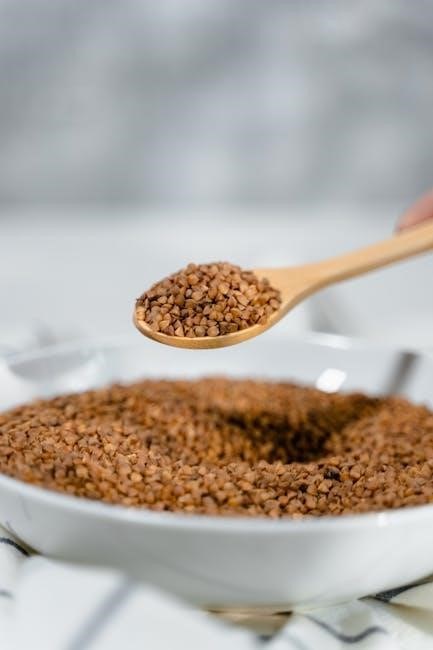Fasting Mimicking Diet (FMD) Overview
The Fasting Mimicking Diet (FMD) is a dietary approach designed to replicate the physiological effects of fasting․ It achieves this while still allowing the consumption of specific foods․ This innovative method provides benefits like weight loss and metabolic health improvements․

What is the Fasting Mimicking Diet?
The Fasting Mimicking Diet (FMD) is a short-term dietary program, typically lasting 3-5 days․ It involves strategic calorie restriction and macronutrient manipulation․ The goal is to provide the benefits of fasting while minimizing the associated adverse effects․
Mimicking Fasting Through Nutrition
The core principle of the Fasting Mimicking Diet (FMD) lies in carefully selecting and consuming specific nutrients․ These nutrients trick the body into believing it is fasting․ This is achieved through calorie restriction, typically around 500 calories on day one, increasing to 800 calories from days two through five․ The diet emphasizes low protein and low carbohydrate intake, favoring plant-based foods․ This nutritional strategy promotes cellular processes like autophagy and metabolic resetting․ By strategically manipulating macronutrient ratios and overall caloric intake, the FMD effectively mimics the beneficial effects of a water fast, all while allowing for the consumption of food․

Benefits of a 5-Day FMD
A 5-day Fasting Mimicking Diet (FMD) offers several potential health benefits․ These include autophagy, which is cellular renewal, and metabolic resetting․ These are often associated with traditional fasting, but achieved through strategic nutrition․
Autophagy and Cellular Renewal
Autophagy, a crucial cellular process, is significantly enhanced by the Fasting Mimicking Diet (FMD)․ This process involves the body’s natural ability to clean out damaged cells and regenerate newer, healthier ones․ During the FMD, the body experiences a period of nutrient scarcity․ This prompts cells to break down and recycle unnecessary or dysfunctional components․ This recycling process supports cellular health, contributing to overall well-being․ The FMD leverages this natural mechanism․ It effectively promotes cellular rejuvenation․ It is by triggering autophagy through strategic dietary restriction․ This process helps in maintaining optimal cellular function․ It promotes longevity and disease prevention․
Metabolic Resetting
The Fasting Mimicking Diet (FMD) facilitates a profound metabolic reset within the body․ By strategically restricting calories and specific macronutrients, the FMD encourages the body to shift its primary energy source․ It shifts from glucose to stored fat․ This metabolic shift promotes weight loss and improves insulin sensitivity․ Additionally, the FMD can positively influence various metabolic markers․ These include cholesterol levels and blood pressure․ The diet’s impact on metabolic pathways helps restore optimal function․ It optimizes the body’s ability to process and utilize nutrients efficiently․ This comprehensive metabolic reset is a key benefit of the FMD․ It helps individuals achieve better overall health and vitality․

DIY FMD Meal Plan
Creating your own Fasting Mimicking Diet (FMD) meal plan allows for customization․ It also ensures adherence to key principles․ This empowers individuals to manage their dietary needs effectively and conveniently․
Creating Your Own Meal Plan
Embarking on a DIY Fasting Mimicking Diet (FMD) meal plan requires careful consideration․ Start by understanding the caloric restrictions essential for mimicking fasting․ Then, prioritize plant-based foods to form the foundation of your meals․ Ensure you meet the macronutrient ratios, emphasizing low protein and low carbs․
Carefully select whole foods to maximize nutritional value․ Plan meals for the entire 5-day period, accounting for varying calorie needs․ Utilizing FMD meal plan PDF resources can provide guidance․ It can help you to ensure that your dietary plan is both effective and sustainable․
Adapt recipes to your preferences, while adhering to the core principles of the FMD․
Key Principles of the FMD
The Fasting Mimicking Diet (FMD) operates on key principles․ These include calorie restriction, specific macronutrient ratios favoring low protein and carbs, and a strong emphasis on plant-based foods․ This approach mimics fasting benefits․
Calorie Restriction Guidelines
Calorie restriction is a cornerstone of the Fasting Mimicking Diet (FMD)․ Typically, the FMD involves significantly reducing daily caloric intake․ On the first day, intake is often limited to around 1100 calories․ From day two through five, daily calories are usually reduced to approximately 800 calories․ These drastic calorie reductions are designed to mimic the physiological effects of a water-only fast, triggering cellular processes like autophagy, while still providing essential nutrients․ This restricted calorie intake helps promote metabolic changes associated with fasting without completely abstaining from food․ Strict adherence to these calorie guidelines is crucial for achieving the desired benefits․
Macronutrient Ratios: Protein, Carbs, and Fats
The Fasting Mimicking Diet (FMD) emphasizes specific macronutrient ratios to maximize its fasting-like effects․ Protein intake is typically very low, often capped around 15 grams per day to minimize the activation of nutrient-sensing pathways․ Carbohydrate consumption is also restricted, favoring complex carbohydrates over simple sugars․ The majority of calories come from healthy fats, particularly plant-based sources like olive oil and hemp seed oil․ These macronutrient ratios are carefully calibrated to trick the body into a fasting state while providing necessary nourishment․ This specific balance supports cellular renewal and metabolic resetting․ Adhering to these macronutrient guidelines is essential for a successful FMD․
Emphasis on Plant-Based Foods
A cornerstone of the Fasting Mimicking Diet (FMD) is its strong emphasis on plant-based foods․ The diet primarily consists of vegetables, fruits, nuts, and seeds, limiting animal products to a bare minimum, if any․ This plant-based approach ensures a rich intake of micronutrients and fiber․ It supports the body’s natural detoxification processes․ Plant-based foods also contribute to the diet’s low protein and carbohydrate profile․ This helps to maintain the fasting-like state․ Furthermore, a plant-focused approach reduces inflammation and promotes overall health․ Prioritizing plant-based meals in the FMD is crucial for achieving its intended benefits․ It supports longevity and optimal bodily function․

Sample FMD Meal Plan (PDF Resources)
Access free FMD meal plan PDFs to simplify your diet․ These resources provide structured meal plans and nutritional tips․ They help you achieve better health and wellness during your fasting period․
Accessing Free FMD Meal Plan PDFs
Discover readily available FMD meal plan PDFs designed to guide you through each day of the diet․ These PDFs offer a structured approach, providing detailed meal plans to help you stay on track and achieve the desired benefits․ Accessing these resources can significantly simplify your planning and preparation process, ensuring you adhere to the diet’s guidelines effectively․
The PDFs typically include daily meal breakdowns, calorie counts, and macronutrient information․ They provide clarity and support for those new to the FMD․ By utilizing these free resources, individuals can confidently embark on their FMD journey with ease and precision․

Recipes for FMD
Explore a variety of FMD-compliant recipes designed to make the diet both palatable and effective․ These recipes focus on plant-based ingredients and controlled macronutrient ratios, ensuring you adhere to the FMD principles while enjoying tasty meals․
Vegan FMD Recipes
For those following a vegan lifestyle, numerous delicious and compliant recipes exist within the Fasting Mimicking Diet framework; These recipes prioritize plant-based whole foods․ They also adhere to the strict calorie and macronutrient guidelines essential for mimicking a fasting state․ You can enjoy options like vegetable soups crafted with olive oil and carefully selected herbs․
These recipes offer variety and satisfaction while supporting the FMD’s goals․ Consider incorporating hemp seed oil for healthy fats․ Also, include plenty of non-starchy vegetables to enhance satiety․ The key is to maintain the low protein and low carbohydrate targets while ensuring adequate micronutrient intake․ This way, you can successfully follow a vegan FMD․

FMD and Longevity Research
The Fasting Mimicking Diet has gained attention due to research suggesting potential longevity benefits․ These studies explore how FMD impacts cellular processes․ They also investigate how FMD influences overall health and lifespan through dietary intervention․
Dr․ Valter Longo’s Research
Dr․ Valter Longo, from the USC Longevity Institute, is a key figure in FMD research, exploring its impact on healthspan․ His multidisciplinary research investigates the effects of dietary interventions․ These dietary interventions include FMD, on cellular aging and overall well-being․ Longo’s work suggests FMD can promote cellular repair and regeneration․
His research also highlights FMD’s potential in reducing the risk of age-related diseases and extending lifespan․ Through rigorous scientific investigation, Dr․ Longo’s findings contribute significantly to understanding FMD’s mechanisms and benefits․ They also contribute to understanding its role in promoting healthy aging and longevity․

Frequency of FMD
The frequency of the FMD depends on individual health goals and needs, with some experts suggesting every 8 to 12 weeks․ This interval allows for sustained benefits and minimizes potential risks․
Recommended Intervals
Determining the recommended intervals for undertaking the Fasting Mimicking Diet (FMD) involves considering individual health status and goals․ Some research suggests that performing the FMD every one to three months may offer optimal benefits for most individuals․ However, consultation with a healthcare professional is crucial to tailor the frequency to specific needs․ Factors such as age, activity level, and existing medical conditions should influence the decision․ A registered dietitian can also provide personalized guidance․ Regular monitoring of health markers can help assess the impact of FMD and adjust the frequency accordingly․ Ultimately, the ideal interval balances maximizing benefits with minimizing potential risks, ensuring sustainable and safe implementation․

FMD vs․ Traditional Fasting
The Fasting Mimicking Diet (FMD) offers a modified approach compared to traditional fasting․ It allows the consumption of specific foods․ It is designed to provide the benefits of fasting․ These are while minimizing the challenges of complete food restriction․
Advantages of FMD over Zero-Calorie Fasting
The Fasting Mimicking Diet (FMD) presents several advantages over traditional zero-calorie fasting․ One significant benefit is its increased sustainability․ Complete food restriction can be difficult to maintain, leading to higher dropout rates․ The FMD’s allowance of specific foods helps manage hunger and cravings․ This makes the dietary plan more tolerable and easier to adhere to over the 5-day period․
Additionally, the FMD provides essential nutrients․ This reduces the risk of malnutrition or nutrient deficiencies that can occur during prolonged zero-calorie fasts․ The strategic intake of macronutrients also supports cellular processes․ These processes include autophagy, while still mimicking the beneficial effects of fasting․ This makes the FMD a safer and more practical option․

FMD and Disease
Research suggests the FMD may delay tumor progression and enhance sensitivity to chemotherapy․ This indicates potential benefits in managing certain diseases․ Further studies are exploring its effects on various health conditions․
FMD and Tumor Progression
The Fasting Mimicking Diet (FMD) is being explored for its potential impact on tumor progression․ Studies suggest that FMD can delay the advancement of tumors in certain contexts․ Additionally, it may increase the sensitivity of various tumor types to chemotherapy․ This could enhance the effectiveness of cancer treatments․
Researchers are investigating how the FMD affects cellular pathways involved in tumor growth and resistance․ The diet’s ability to mimic fasting while providing nutrients is key․ This approach aims to create an environment that is less favorable for cancer cells, offering a promising avenue for further research and potential therapeutic applications․